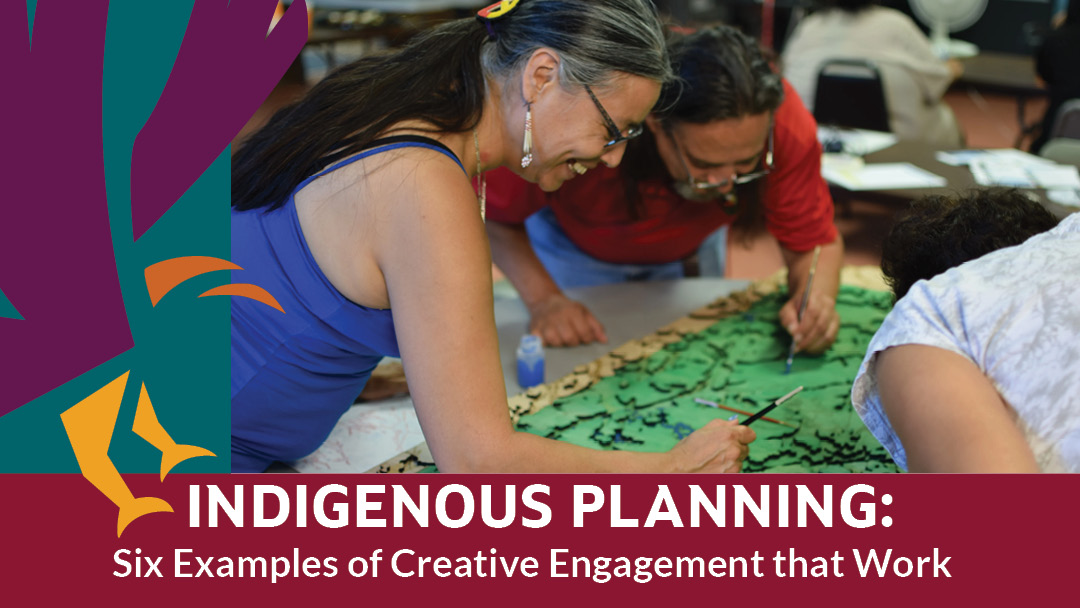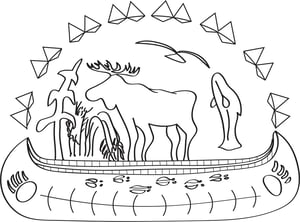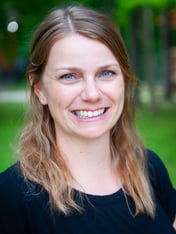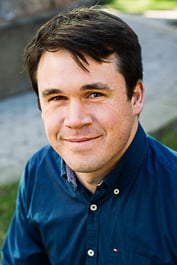
“Our 3-D map was put together, painted and decorated by our community members. It is a teaching tool for our members, from community history to future planning.” – Samantha Noganosh, Head Councilor and Lands Clerk, Magnetawan First Nation
We know that having as many people from your Indigenous Nation engaged in your land use planning process as possible is a powerful way to ground the plan in your Nation’s values, visions and priorities. But, people are busy. Your planning process is competing with the demands of family, health, school, and work commitments. How many of us would like to be involved but end up feeling disconnected from what’s going on in our communities, convinced we don’t have anything to contribute?
In our travels, we’ve encountered some innovative approaches Indigenous Nations are using to meaningfully engage people in the planning processes that will have an impact on their lives.
Below is a selection of six examples of creative approaches to get your own ideas flowing. Tune in next week when we follow up this post with a Community Engagement Checklist.
Six examples of creative approaches to community engagement
Share project information farther and wider: Multimedia, multiplatform communication
Example #1: Shawanaga First Nation Videos – Land Use Planning and Environmental Management Planning
It sounds simple, but if you want people involved in a project, they need to know about it. You know where your audience likes to get its information: put your message where they’ll see it. Online, Facebook is a good bet, but distributing across many social channels will likely hit more of your audience.
Shawanaga First Nation chose video to get the message about their land use and environmental planning out to their citizens and beyond. “Anishnabe people are visual and hands on learners,” says Tobias. “So these videos really hit home. Thousands of views in less than a few hours.” Read our blog about Shawanaga’s story and how to use video for maximum impact here.
Or watch the video here:
Providing people with clear and accessible information about a project is key! Make sure your message is delivered in a format and in language people will easily understand. If they have to figure out what you’re on about, you’ve already lost them. Test out any communication before you send it – ask an Elder, ask a child if your message is clear.
To reach the widest audience possible (from youth members to elders), share information through as many different media as possible. Here are some examples:
- Hang information posters around the community
- Mail out community flyers – and no, paper mailouts are not dead. Stats show people do look at things that arrive by mail.
- Send emails and post on your website and Facebook page
- Host a community meeting and provide lunch
- Get your community champion (more about that below) to visit people’s homes and talk about the project
Not only does the community need access to information, but people need to be ignited with a reason and incentive to participate in community planning. Project content should be impactful! It should speak to what matters most to people. It should make people see themselves and their concerns reflected in what’s happening.
Tip: Don’t forget to include contact information for the community champion to make it easy for people to respond and get involved – a phone number and an email, for example.
Go to where the people are: Community feasts, pow wows, school presentations, Elder’s homes for tea
Example #2: Wasauksing First Nation Youth Pizza Lunch
Don’t assume that people will just show up to an information or engagement session (especially if there’s no food). Get creative and go to where the people are!
When Wasuksing First Nation wanted the youth perspective on their land use planning, they brought pizza to the local highschool and had an enlightening chat with the students about where young people play, hang out, and use the land. The visit was a chance for an unscripted conversation that added valuable information to the planning process. At the same time, it created the opportunity for the voice of the nation’s youth to be heard – and for those young people to know their voices matter.
Example #3: Magnetawan Land Use Study - Participatory video
When it comes to youth engagement, follow their lead. Sometimes this means letting them show you their world, their way.
A few years ago, when we were assisting Magnetawan First Nation with a Land Use and Occupancy study, we put video cameras into the hands of the youth, and asked them to document the places they loved the most. The footage that came back gave a unique and powerful perspective on what mattered to the youth – a glimpse into a world us adults seldom get to see.
Watch a clip of that video here.
Tip: Make sure whoever is filming understands the power of picking a scene and STAYING STILL for at least five to ten seconds at a time. Otherwise whoever is reviewing the footage better have a strong stomach and like rollercoasters.
Tip: Make sure you capture good quality audio, especially of people’s voices. Use headphones and listen back to your recording, to make sure it sounds good. If people have a hard time understanding what someone is saying, they won’t watch the video.
Engaging Elders
Another valuable perspective that you might miss at bigger meetings is that of your Elders. If you want to engage elders, particularly those with mobility or hearing challenges, try stopping by their homes for a cup of tea. For those visits, consider bringing a voice recorder to document the conversation.
Piggy back on what’s already happening
Another idea is to piggyback on other community events or meetings where you know members will already be in attendance. For instance, set up a land use planning information booth at your nation’s pow wow and get people to share some of their visions and hopes on a visioning board.
Include interactive activities: 3-D mapping, photo voice or participatory video projects
Example #4: Magnetawan First Nation 3-D Mapping
Using interactive activities can be a great way to capture community visions for land use planning. As part of their land use planning process, Magnetawan First Nation invited community members to help build a 3-Dimensional model of their community. It was a great way to engage community members about the land use plan while creating a useful resource for the planning process. As Samantha Noganosh from Magnetawan First Nation says,

“Our 3-D map was put together, painted and decorate by our community members. It is a teaching tool for our members, from community history to future planning.” – Samantha Noganosh, Magnetawan First Nation Head Councilor and Lands Clerk
Photo: Angie Noganosh and Anthony LaForge working on the 3D map
Everyone who sees this model wants one! Watch this space for a detailed how-to blog on this super impactful planning tool.
Integrate a little incentive through some healthy competition: Photo and logo competitions
Example #5: Shawanaga First Nation logo competition
Example #6: Driftpile Cree Nation photo contest
Sometimes, people just need incentive to participate in activities and that’s okay! Providing incentive through fun competitions such as photo or logo contests is a great way to get people involved and excited about the project while generating content for your plan.
Shawanaga First Nation’s logo contest generated some beautiful artwork. The first prize winner’s logo was featured on the cover of their Land Use and Environmental Plans, and runners up had their work displayed in the document.
Driftpile Cree Nation’s photo contest yielded an astonishing selection of fantastic imagery. Not only could people celebrate the beauty of the land, their plans became that much more accessible because people could see the land they love reflected in the plans themselves.
Create a fun contest poster and share it far and wide. Announce prizes for a) best landscape photo b) best photo of people out enjoying the land c) best harvesting photo, and so on. Make sure you build prizes into your planning budget!
Tip: Make sure people have the supplies they need to participate. For example, bringing some art supplies to the local school might help your budding artists more easily engage in your contest.
The secret ingredient: Pick the right community champion
Having a dedicated community champion for your planning process is the secret ingredient for ensuring that great community engagement happens. A community champion should be someone that is connected to the community and its members, someone that is enthusiastic about the project, and someone that is organized and able to multi task. The right community champion will get the job done!
Looking for a quick overview of some planning options you might be considering?
Looking for help with community engagement? Or other planning help?
If you are trying to figure out how to get started, do give us a shout. We’d be happy to discuss your options and help you weigh the pros and cons of your planning options. We’re a team of self-proclaimed planning geeks who love to talk about this stuff, so don’t hesitate to get in touch.
.jpg?width=171&height=257&name=Jeremy%20(2).jpg)
|
JEREMY SHUTE, MA, RPP SENIOR PLANNER
(226) 706 8888 ext. 105
Jeremy Shute has a broad background in resource, land use and community planning and communications. He is a professional planner as well as a mediator, facilitator and cartographer. He has been involved in land use planning and in the planning profession in a variety of capacities including mentoring new planners, evaluating land use planning processes, teaching land use planning courses, working with Indigenous communities to develop land use plans, integrating community values and land use and occupancy data into community and land use planning processes and reviewing development proposals within the context of land use plans. He specializes in integrating local and traditional knowledge and community values in project planning and regulatory processes such as environmental assessment. Jeremy has worked in the energy, waste management, forestry, mining, transportation, contaminated sites and water management sectors. He has worked at the interface of development projects and Indigenous communities in a wide range of settings in Ontario, Quebec, Nova Scotia, Nunavut, Manitoba, Saskatchewan, Alberta and British Columbia.
|

|
LAURA SAYERS, HBSc, PMP SENIOR CONSULTANT
(226) 706 8888 ext. 129
As a Senior Consultant with SVS, Laura strives to support clients with collaborative land stewardship practices, responsible development, and informed decision-making. She values the importance of community-led initiatives, communication, and relationship building. She believes in the concept of “stewardship of the lands for future generations.” This idea motivates her work. Laura comes to SVS with over 16 years of experience providing project management and technical advisory services to Indigenous communities on minor and major capital projects, community development, strategic planning, capacity building, training, community engagement and environmental issues. She has worked on a wide range of projects including soil remediation, solid waste management, community planning, power generation, distribution and transmission, climate change, renewable energy, energy conservation, community infrastructure, and more. Laura is a PMI-certified Project Management Professional (PMP) and holds an Honours Bachelor of Science in Earth and Environmental Science from McMaster University.
|

|
ANDREW PEACH, MSc PLANNING CONSULTANT
(226) 706 8888 ext. 150
Andrew is a Planning Consultant and Project Manager who joined SVS in 2017. Prior to this, Andrew worked in the non-profit sector designing economic development and mentorship projects for Indigenous communities across Canada as well as monitoring and evaluating international projects. Andrew comes to SVS with a diverse background that includes qualitative research methodology and social research, community economic development, project management, facilitation, and monitoring and evaluations. He has developed and coordinated projects in Nunavut, the Northwest Territories, and Ontario for diverse partners and clients including band councils, social enterprises, small businesses and various levels of government. Outside of Canada he has monitored and evaluated projects related to governance and capacity building, microfinance, and small and medium enterprise development, and he has conducted research in rural Mexico on collaborative resource management and community decision-making regimes. He also has a strong background in facilitation and public participation. Andrew is a strong proponent of community-led development and public participation in planning. He believes that for plans to be successful in developing resilient communities they must place community voices at the center. Andrew has a Master’s of Science (Planning) in Rural Planning and Development from the University of Guelph and a Bachelor’s of History from Queen’s University. |
Like what you're reading? Get future posts delivered right to your inbox:
About Us: Shared Value Solutions
We are a Canadian B Corp, and we assist Indigenous communities with support throughout regulatory processes surrounding major development projects like mines, hydroelectric facilities, transmission lines, highway expansions, oil and gas pipelines, natural resource transport applications and nuclear power.
We have deep context and experience behind the recommendations we provide, having worked for our clients on almost every major project in Canada over the last 10 years. For us, it’s all about building long-term relationships with our clients. We want to get to know you and what you want to do so we can help you move your plans forward.
- Reviews of Environmental Assessments and Environmental Impact Statements
-
Strategic Regulatory and Environmental Assessment Process Support
- First Nation Land Code communities
- Indigenous Guardian programs
- Impact Benefit Agreements: technical and regulatory support for negotiations
- Indigenous Jurisdiction initiatives: joint management agreements and co-management agreements
- Community-based Indigenous environmental monitoring
- Indigenous Land Use Planning
- Participant funding negotiation and application support
- Multimedia Storytelling


